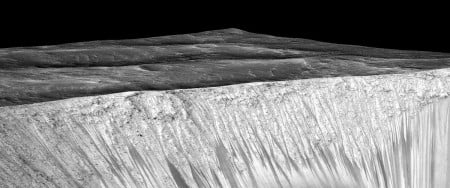Some science news is just too good to not write up, and the next place humans are set to explore has its first signs that life could still exist.
A spacecraft orbiting Mars has picked up some interesting information, as NASA has this week suggested that it has the strongest evidence that water currently flows on Mars, and didn’t just do so in the past.
Researchers at NASA’s Jet Propulsion Laboratory have studied images taken through a variety of passes which have shown dark streaks that change over time, with this information suggesting liquid could appear at times of the year on the planet, receding at other times when the temperature drops.

“Our quest on Mars has been to ‘follow the water,’ in our search for life in the universe, and now we have convincing science that validates what we’ve long suspected,” said John Grunsfeld, Astronaut and Associate Administrator of NASA’s Science Mission Directorate.
“This is a significant development, as it appears to confirm that water — albeit briny — is flowing today on the surface of Mars.”
This water, NASA says, could hold the potential for life currently in the liquid, and may even point to signs of how the red planet could support life later on, helping to provide answers about the history of the planet, but also how humans could one day travel there.
“It took multiple spacecraft over several years to solve this mystery, and now we know there is liquid water on the surface of this cold, desert planet,” said Michael Meyer, Lead Scientist for NASA’s Mars Exploration Program.
“It seems that the more we study Mars, the more we learn how life could be supported and where there are resources to support life in the future.”

So what does this mean?
Well it doesn’t mean we’re any closer to finding little green men, so all of you hoping and dreaming for an alien race to make Star Trek-esque first contact with may as well just keep hoping and dreaming, or even wearing those tin foil hats and telling you that everyone is lying to you.
Rather, what it tells us is that some form of life could exist on Mars, and hints at when the right time to launch expeditions on the planet might be, as well as to where to possibly find out more.
It is a great discovery, though, because next stop we confirm life somewhere other than our little pebble in the universe.

Dark, narrow streaks on Martian slopes such as these at Hale Crater are inferred to be formed by seasonal flow of water on contemporary Mars. The streaks are roughly the length of a football field. Image and caption by NASA’s Jet Propulsion Laboratory.








